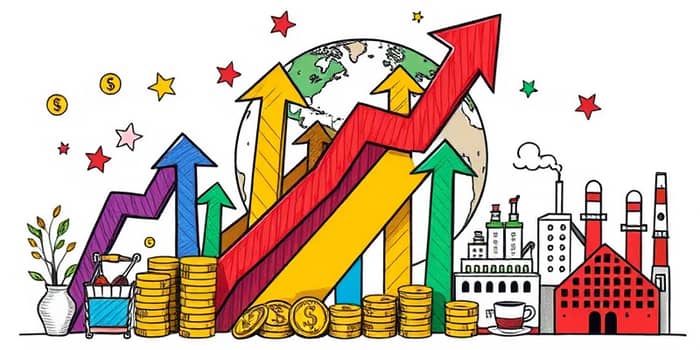Inflation is no longer a distant concept; it’s a daily reality for millions of individuals and businesses navigating an ever-changing economic terrain.
From the price of your morning coffee to the cost of raw materials for manufacturers, each decision is shadowed by the specter of rising costs and shifting expectations.
As families and companies alike grapple with these pressures, understanding the forces at play becomes critical to crafting resilient strategies and seizing emerging opportunities.
Understanding Current Inflation Trends
Recent data offers a mixed portrait of inflation across major economies.
- Core US services inflation fell to 3.6% in April 2025, its lowest level since November 2021
- G5 economies’ monthly consumer price inflation rate for services dropped to 3.5%
- G5 core goods inflation rate rose to 0.6%, indicating gradual upward pressure on goods inflation
- Global headline inflation is projected to decline to 4.2% in 2025 and 3.5% in 2026
- Euro area headline inflation is expected to meet the ECB’s 2% target by mid-2025
While service prices have cooled as pandemic-fueled demand normalizes, goods inflation has edged upward, fueled by supply chain constraints and rising commodity prices.
This duality underscores the importance of dissecting inflation into its component parts, revealing divergent dynamics that shape consumer behavior and corporate planning.
Drivers of Inflation and Economic Dynamics
Beyond headline figures, several underlying forces drive today’s inflationary backdrop. One prominent factor is front-loading of economic activity to avoid expected tariff, which distorted quarterly growth readings.
In Q1 2025, US real GDP contracted primarily due to a surge in imports as businesses accelerated purchasing ahead of looming trade barriers.
Yet resilient consumer spending and investment growth helped final sales to domestic purchasers climb at a healthy 3% annualized rate, signaling that demand remains sturdy despite rising prices.
Services disinflation has become more pronounced as sectors like hospitality and healthcare adjust capacity, while goods inflation reflects lingering shortages and transportation bottlenecks.
Market Reaction and Volatility
Financial markets have been particularly sensitive to each inflation report, tariff announcement, and labor market update.
Whenever readings diverge from forecasts, stocks sway and bond yields move swiftly, leaving investors scrambling to recalibrate risk exposures.
The VIX and MOVE indexes vividly illustrate increased volatility in equity and bond markets, capturing the anxiety that permeates trading floors and boardrooms alike.
As the Federal Reserve approaches the bottom of its rate-cutting cycle, projected around 3.0–3.5% by late 2025, markets may grow even more jittery over the Fed’s flexibility to ease further in the face of persistent inflation.
High equity valuations combined with cautious earnings growth forecasts could temper stock returns, while concerns about renewed price pressures may limit central bank maneuver room.
Sectoral Impacts and Consumer Experience
Inflation affects each sector differently, creating winners and losers across the economic landscape.
Property owners often benefit as rents and real estate prices adjust upward, providing a hedge against general inflation.
Conversely, savers holding cash or fixed-rate instruments may feel their earnings eroded over time, emphasizing the importance of inflation-aware portfolio design.
Manufacturers and service providers face the continual challenge of balancing higher input costs with customer expectations, with pricing power becoming a critical strategic lever.
Global Factors and Future Outlook
Tightening of global trade growth, projected to dip to 1.7% in 2025, coupled with geopolitical conflicts from Ukraine to the Red Sea, heightens supply chain uncertainties.
Central banks in the G5 economies have moderated services inflation but grapple with stubborn goods price pressures and evolving wage dynamics.
Despite strong labor markets, consumer sentiment has soured, reflecting uncertainty and tightening financial conditions that weigh on household budgets and business confidence.
Looking ahead, US real GDP growth is forecast at around 2.0–2.1% for 2025–2026, embodying a “soft-landing” scenario if inflation remains contained and policy shifts stay predictable.
Strategies for Businesses and Individuals
Facing this complex environment, proactive planning is essential. By taking proactive steps can help navigate inflationary pressures, stakeholders can protect assets and capitalize on emerging trends.
- Diversify investments into inflation-protected securities such as TIPS
- Adjust business pricing strategies and renegotiate supplier contracts
- Lock in long-term financing at fixed interest rates where possible
- Build and maintain a robust emergency fund to preserve liquidity
- Consider real assets like real estate or commodities as long-term hedges
For companies, agile supply chain management and transparent customer communication on pricing rationale foster trust and competitiveness.
On an individual level, maintaining a balanced portfolio, monitoring budgeting tools, and seeking professional advice can quell anxiety and build financial resilience.
Ultimately, the story of inflation reshaping today’s market is one of adaptation, agility, and foresight.
Stakeholders who immerse themselves in data-driven insights, adopt flexible strategies, and remain vigilant will not only weather the current cycle but also emerge stronger in the next phase of economic evolution.
By understanding the intricate forces at play, from tariff-induced distortions to shifting consumer behavior, we gain the clarity needed to navigate uncertainty and harness the opportunities that lie ahead.
Remember, inflation cycles are natural components of economic expansion and contraction, and history shows that each inflationary period lays groundwork for innovation and growth in subsequent years.
References
- https://www.spglobal.com/market-intelligence/en/news-insights/research/global-economic-outlook-may-2025
- https://www.imf.org/en/Publications/WEO/Issues/2025/01/17/world-economic-outlook-update-january-2025
- https://economy-finance.ec.europa.eu/economic-forecast-and-surveys/economic-forecasts/spring-2025-economic-forecast-moderate-growth-amid-global-economic-uncertainty_en
- https://www.imf.org/en/Blogs/Articles/2025/04/22/the-global-economy-enters-a-new-era
- https://www2.deloitte.com/us/en/insights/economy/global-economic-outlook-2025.html
- https://www.ibrc.indiana.edu/ibr/2024/outlook/finance.html
- https://en.wikipedia.org/wiki/Inflation
- https://www.diamond-hill.com/insights/a-780/articles/market-volatility-in-2025-tariffs-inflation-and-the-consumer-impact/










